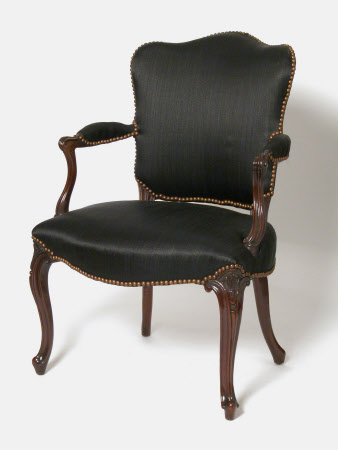Open armchair
possibly John Cobb (1715 - 1778)
Category
Furniture
Date
circa 1770
Materials
Mahogany, horsehair, metal studs, webbing, hessian, beech, later beech and softwood repairs
Measurements
90.5 x 62 x 58 cm
Place of origin
London
Order this imageCollection
Erddig, Wrexham
NT 1146959.5
Summary
A mahogany-framed open armchair, English, possibly made by John Cobb (c.1710-1778), circa 1770, one of a set of eight pieces of seat furniture, comprising six open armchairs [NT 1146959.1-.6], a standard chair without arms [NT 1146959.7] and a sofa [NT 1146959.8]. All now covered in close-nailed black horsehair; replacing previous ribbed silk covers. The underside of the seats with extensive repairs, carried out in the 1980s. Having a completely-covered cartouche-shaped back above short, moulded rear supports. The arms open and curved and partly padded and upholstered; their terminals scroll-carved and moulded and on moulded arm supports. The shaped, broad seat covered in close-nailed black horsehair entirely obscuring the seat rails and raised on a pair of moulded cabriole front legs, each carved at the knee with a scallop shell or fan within bordering scrolls. The rear legs outswept.
Full description
This set of seat furniture has traditionally been attributed to John Cobb on the basis of a payment to John Cobb (c.1710-1778) in one of Philip Yorke I’s (1743-1804) pocket or commonplace books, but the amount of the payment itself does not appear to have been published. They are stylistically comparable to other chairs thought to have been made by Cobb (c.1710-1778), but the payment itself, made on the 16 September 1770 ‘To Cobb, p[e]r Rec[ei]pt…022:00:0’ does not seem quite enough to cover a set of seven (probably originally eight) chairs and a sofa [D/E/335]. Of course, the original price would have been materially affected by the quality and type of the fabric which covered them, a fact we cannot know because Cobb’s bill does not survive, only this memorandum of the payment made by Philip Yorke I. That this payment – recorded simply as to ‘Cobb’ – was made to John Cobb the cabinet-maker, and not some other debtor of the same name, is made more likely by a comment made by Elizabeth Cust (1750-1779), who married Philip Yorke I in July 1770, in a letter to her fiancé several months before their marriage. Engaged after a lengthy courtship, Philip and his bride-to-be embarked on a shopping spree, facilitated by the inheritance which came to Philip and his mother, Dorothy (d. 1787) from her brother, James Hutton, who died in the same year. Philip’s meticulous records reveal that the couple spent money on silver, clothes and entertainments such as a Johann Christian Bach (1735-1782) concert in fashionable Mayfair. Writing to Philip on 14 April 1770, Elizabeth asked ‘What think you of a Library? not a wooden one like that we saw at Cobs’ [Wherry, Erthig on the Dyke, p. 125], indicating that the pair had paid a recent visit to Cobb’s showroom. An entry in the accounts of Philip’s steward at Erddig, John Caesar, on 6 October 1770, of a payment of 5s to the ‘Team at Chester fetching Chairs’, may well be related [D/E/377], although no mention is made of a sofa. Philip and Elizabeth also made payments to other London cabinet-makers and upholsterers, like William France (d. 1773) and Michael Thackthwaite (1754-1795), so it is possible that this set of seat furniture was made by one or other of these competitors. For instance, in February 1772, a far more significant payment of £192 was paid ‘To Thackthwaite Cab[ine]t Maker’ [D/E/1212]. It is also possible that these chairs were originally made for James Hutton’s London house in Park Street, or his Hertfordshire estates of Newnham and Radwell, and inherited by Philip and his mother in 1770, since some of the contents of both properties were removed to Erddig in the 1770s and 1780s. (Megan Wheeler, January 2019)
Provenance
Given by Philip Yorke III (1905-1978) along with the estate, house and contents to the National Trust in 1973.
Makers and roles
possibly John Cobb (1715 - 1778), cabinet-maker
References
Wherry, Albinia, 1857-1929 Chronicles of Erthig on the Dyke MCMXIV [1914]., p. 125 Cragg, 2002: J. Cragg. “Room for improvement: the re-arrangement of room furnishings at Erddig.” Apollo 155.482 (2002): pp.36-40., p. 38 Flintshire Record Office D/E/335 Flintshire Record Office D/E/377 Flintshire Record Office D/E/1212
